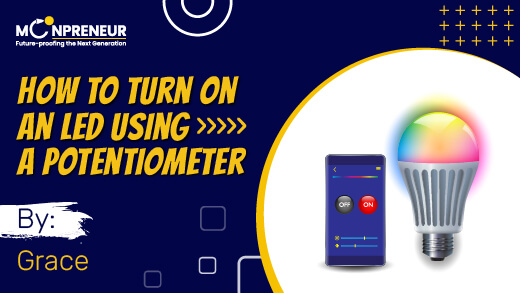MoonCampaign by Grace (12 years)

Our Social Impact - We're transforming education globally with free robotics and math workshops in the US, UK,
Canada, and Australia.
Our workshops have helped 66,000 students alone in the US plus 14,000 students benefit from our four-week sessions.
How to Turn on an LED Using a Potentiometer
Grace
Show n Tell
Show n Tell
Coming Soon
Grace's "How to Turn on an LED Using a Potentiometer" project is a simple yet insightful demonstration of how a potentiometer can regulate the brightness of an LED by varying the resistance in a circuit. Using just a potentiometer, 9V battery, and an LED, Grace creates an intuitive system where adjusting the potentiometer changes the current flow, controlling the LED’s brightness. This hands-on project offers a beginner-friendly introduction to basic electronics, resistance, and circuit behavior, highlighting how small adjustments can have a significant impact. It inspires practical applications, such as dimmable lighting or volume controls in everyday devices.
Understanding how electricity can be controlled and manipulated has always fascinated me. My project, "How to Turn on an LED Using a Potentiometer," demonstrates how a potentiometer can be used to regulate the brightness of an LED. Using only a potentiometer, a 9V battery, and an LED, I created a simple circuit that showcases the basics of variable resistance and its impact on current flow.
The potentiometer in this project acts as a dimmer, allowing me to adjust the brightness of the LED by varying the resistance. At low resistance, the LED glows brightly as more current flows through it. Increasing the resistance dims the LED, providing an intuitive way to understand how electrical circuits behave. The 9V battery supplies the power, while the potentiometer bridges the gap between the battery and the LED, ensuring a smooth control mechanism.
This project is perfect for beginners wanting to explore electronics without needing any coding knowledge. It offers a hands-on introduction to the concept of resistance and how it impacts electrical components. Building this circuit taught me how small adjustments could make a big difference, and it inspired me to think about practical applications, such as dimmable lights or volume controls in everyday devices.
©️ Copyright, Moonpreneur Inc.
3031 Tisch Way, 110 Plaza West PMB # 138, San Jose, CA 95128, USA
Likes
Rating
62 days left
How to Turn on an LED Using a Potentiometer